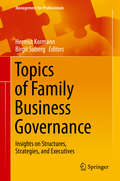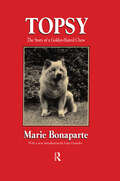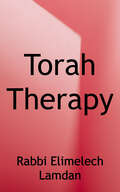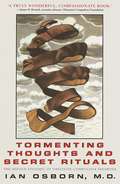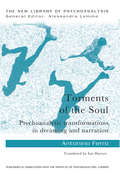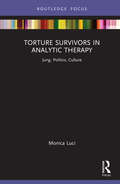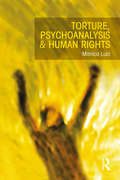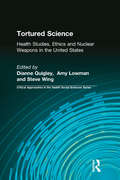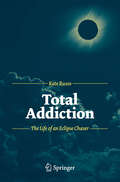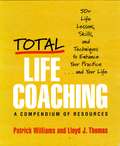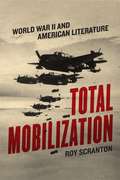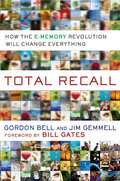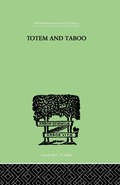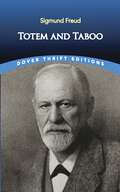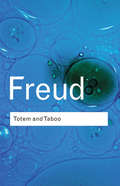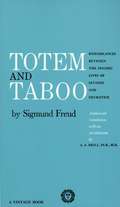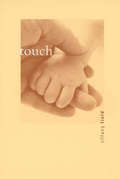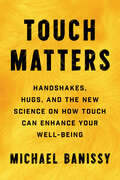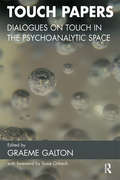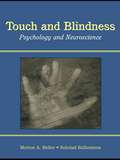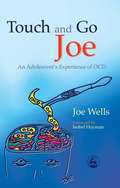- Table View
- List View
Topics of Family Business Governance: Insights on Structures, Strategies, and Executives (Management for Professionals)
by Hermut Kormann Birgit SubergThis book focuses on the role of the board in family businesses and specifically on processes and topics of strategic importance. It comprises all the relevant topics which need to be addressed on a regular basis such as strategy development, financial management, and leadership. The pros and cons of each issue are elaborated. This is one of the few books which addresses family businesses from governance systems to the role of executives. The diverse set of examples carefully collected by the authors and an in-depth discussion on the topics provide readers with valuable insights to broaden and enrich the effectiveness of governance.
Topsy: The Story of a Golden-haired Chow (History of Ideas Series)
by Marie BonaparteTopsy is a psychoanalytic tale of the effects of a dog on its owner; the analyst is the great Marie Bonaparte. Only after being told that her dog had cancer did she realize the attachment she developed to Topsy. She describes the emotions she experienced during the time of Topsy's illness and subsequent healing. Written in France and Greece at the onset of World War II, the story of Topsy's cancer clearly is intended to convey the ills of Europe at that time.Bonaparte's relationship with her dog reveals her own fears about aging, dying, being alone, as well as the uncertainty of the political situation. As she tells her story, Bonaparte is reminded of the experience of her father, who also suffered from cancer. Topsy, while not written as a scientific study, provides insight into the psychoanalytical effects of relationships between humans and animals. It tells us much about one of psychotherapy's founding personages as well as the members of her professional circle in a critical period of European history.In the new introduction, Gary Genosko reflects on Sigmund Freud's own affection for, and use of, dogs in his analyses. He goes on to describe the relationship between Freud and Bonaparte and how dogs played a significant part in that companionship. Topsy will be of interest to psychologists, psychiatrists, and those who love, and have been loved by dogs.
Torah Therapy: A Guide to Therapy in the Spirit of Torah
by Rabbi Elimelech LamdanA profound and eye-opening look at the principles and practices of Torah Judaism, and their integration into effective therapy. With depth and brilliance, the author, an accomplished therapist and Rosh Kollel, takes a behind-the-scenes look at the human persona from the Torah perspective, delving into such topics as yetzer ha-ra, middos, anger, hatred, withdrawal, and aggression. This book makes enriching reading for the professional therapist, as well as every person who seeks self-awareness and healing.
Tormenting Thoughts and Secret Rituals: The Hidden Epidemic of Obsessive-Compulsive Disorder
by Ian OsbornObsessive-compulsive disorder has been called the "hidden epidemic": only a very few of the many people who have it reveal their condition. Ian Osborn is one of those who suffers from OCD, and his personal experience imbues this book with an exceptional clarity and understanding.Dr. Osborn discusses the various forms OCD takes and--using the most common focuses of obsession--presents detailed and dramatic cases whose objects are filth, harm, lust, and blasphemy. He explains how the disorder is currently diagnosed, and how it differs from addiction, worrying, and preoccupation. He summarizes the recent findings in the areas of brain biology, neuroimaging, and genetics that show OCD to be a distinct chemical disorder of the brain. He contrasts OCD with other "OCD spectrum disorders" such as anorexia nervosa and hairpulling, and he provides a historical overview that traces the development over the centuries of both behavior therapy and medications.
Torments of the Soul: Psychoanalytic transformations in dreaming and narration (The New Library of Psychoanalysis)
by Antonino FerroIn Torments of the Soul, Antonino Ferro revisits and expands on a theme that has long been at the heart of his work: the study of dreams during sleep and in the waking state, and the psychoanalytic narrative. Following Bion, he focuses on the importance of what he sees as the task of contemporary psychoanalysis for generating, containing and transforming previously unmanageable emotions with a clinical psychoanalytic context. Antonino Ferro explores the concepts of 'transformations in dreaming', the session as a dream, individuals transformed into characters, the interpretation of these characters, and readings of them as the functioning of a single mind or as an analytic field created by the meeting of two minds: the client's and the analyst's. Here, a new identity, the analytic field, is formed from the reverie of both participants, which makes it possible to work on complex, nonlinear phenomena in a radical way, creating a 'royal road' to the unconscious communication of the patient. Torments of the Soul contains a plethora of clinical vignettes from the author's extensive psychoanalytic work with adults and children to illustrate the substantial theoretical progression he advocates here. Offering significant and important new interpretations of theories and ways of working with patients, this book will be essential reading for psychoanalysts, psychotherapists, psychologists, students of these fields and those interested in the human sciences.
Torture Survivors in Analytic Therapy: Jung, Politics, Culture (Focus on Jung, Politics and Culture)
by Monica LuciThis important new book introduces and discusses the underpinning of psychodynamic psychotherapy for torture survivors in a clinical setting and incorporates concepts from analytical psychology and other theoretical bases in order to provide readers with a deeper understanding of this complex trauma. Using the concepts of analytical psychology, relational psychoanalysis, and neuroscience, and relying on the theoretical basis of her book Torture, Psychoanalysis and Human Rights (Routledge, 2017), Luci focuses on three key clinical cases and illustrates the therapeutic paths that the therapeutic dyad explore and experiences in order to get out of the patient’s inner prison created or aggravated by the experience of torture. The book discusses the role of the therapist when working with torture survivors, the requirement of a slow and cautious approach when dealing with such trauma, and the importance of a careful and respectful consideration of issues of identity, politics, and culture. Featuring a useful guide, this book will be of great interest to mental health professionals, psychotherapists and students practicing in services that provide assistance to torture and war trauma survivors.
Torture and Dignity: An Essay on Moral Injury
by J. M. BernsteinIn this unflinching look at the experience of suffering and one of its greatest manifestations--torture--J. M. Bernstein critiques the repressions of traditional moral theory, showing that our morals are not immutable ideals but fragile constructions that depend on our experience of suffering itself. Morals, Bernstein argues, not only guide our conduct but also express the depth of mutual dependence that we share as vulnerable and injurable individuals. Beginning with the attempts to abolish torture in the eighteenth century, and then sensitively examining what is suffered in torture and related transgressions, such as rape, Bernstein elaborates a powerful new conception of moral injury. Crucially, he shows, moral injury always involves an injury to the status of an individual as a person--it is a violent assault against his or her dignity. Elaborating on this critical element of moral injury, he demonstrates that the mutual recognitions of trust form the invisible substance of our moral lives, that dignity is a fragile social possession, and that the perspective of ourselves as potential victims is an ineliminable feature of everyday moral experience.
Torture, Psychoanalysis and Human Rights
by Monica LuciTorture, Psychoanalysis and Human Rights contributes to the development of that field of study called ‘psycho-social’ that is presently more and more committed to providing understanding of social phenomena, making use of the explicative perspective of psychoanalysis. The book seeks to develop a concise and integrated framework of understanding of torture as a socio-political phenomenon based on psychoanalytic thinking, through which different dimensions of the subject of study become more comprehensible. Monica Luci argues that torture performs a covert emotional function in society. In order to identify what this function might be, a profile of ‘torturous societies’ and the main psychological dynamics of social actors involved – torturers, victims, and bystanders – are drawn from literature. Accordingly, a wide-ranging description of the phenomenology of torture is provided, detecting an inclusive and recurring pattern of key elements. Relying on psychoanalytic concepts derived from different theoretical traditions, including British object relations theories, American relational psychoanalysis and analytical psychology, the study provides an advanced line of conceptual research, shaping a model, whose aim is tograsp the deep meaning of key intrapsychic, interpersonal and group dynamics involved in torture. Once a sufficiently coherent understanding has been reached, Luci proposes using it as a groundwork tool in the human rights field to re-think the best strategies of prevention and recovery from post-torture psychological and social suffering. The book initiates a dialogue between psychoanalysis and human rights, showing that the proposed psychoanalytic understanding is a viable conceptualisation for expanding thinking of crucial issues regarding torture, which might be relevant to human rights and legal doctrine, such as the responsibility of perpetrators, the reparation of victims and the question of ‘truth’. Torture, Psychoanalysis and Human Rights is the first book to build a psychoanalytic theory of torture from which psychological, social and legal reflections, as well as practical aspects of treatment, can be mutually derived and understood. It will appeal to psychoanalysts, psychoanalytic psychotherapists and Jungians, as well as scholars of politics, social work and justice, and human rights and postgraduate students studying across these fields.
Tortured Science: Health Studies, Ethics and Nuclear Weapons in the United States (Critical Approaches in the Health Social Sciences Series)
by Dianne Quigley, Amy Lowman, and Steve WingThe U.S.A. s nuclear weapons program has exposed workers and the public to health hazards since World War II. In the 1980s and 1990s, federal health agencies responded to new revelations about these hazards by pouring millions of dollars into research on the health impacts of radiation. In Tortured Science: Health Studies, Ethics and Nuclear Weapons in the United States , community health activists and researchers reflect on the research program for addressing the health effects of nuclear weapons production at Hanford, WA, Rocky Flats, CO, Livermore Labs, CA, and Fernald, OH. The authors describe conflicts of interest, data suppression, technical inadequacies, and other examples of how researchers failed in their social responsibility to the affected human populations. The research program s health studies did not lead to any meaningful follow-up on the major health concerns of community members, nor have they helped communities seek reparations for high radiation exposures that may have contributed to thyroid, bone, lung and other diseases. In Tortured Science , several ethicists review these health research problems. Research ethics as a discipline seeks to protect individuals and groups, obtain approval from affected communities, mitigate potential research harms, and guard against vigilance, scientific contrivance, denial, and suppression of findings. Such protections were not adequately provided in the research program on the health effects of nuclear weapons production, as critiqued in the ethical reviews. This book compels us to develop a new ethical framework for scientific research on military-industrial and other sources of contamination. Intended Audience: Public health professionals; graduates/undergraduates in public health, community health, environmental studies, epidemiology, medical anthropology, public sociology, ethics/religious studies, and science policy; government health researchers at federal health agencies, centres for ethics and bioethics (private/academic), and community health organisations; community-based researchers and environmental organisations; nuclear weapons and peace organisations.
Total Addiction
by Kate RussoSeeing a total solar eclipse is often described as a once-in-a-lifetime experience. However, for many who have experienced totality, once-in-a-lifetime is simply not enough. They want more, and are willing to go to great lengths often at great expense to repeat the experience. What is it like to experience totality? What is it about the experience that motivates these eclipse chasers? Is there an eclipse chaser personality? Can eclipse chasing actually be described as an addiction? This book describes the people who dedicate their lives to chasing their dream.
Total Life Coaching: 50+ Life Lessons, Skills, and Techniques to Enhance Your Practice . . . and Your Life
by Patrick Williams Lloyd J. ThomasTotal Life Coaching by Pat and Lloyd is more than just a book. It is an interactive experience in which you will find recipes for living your life more authentically, as well as master time-honored lessons that you can bring to your coaching clients. Regardless of the personal coaching techniques or skills you may have learned, you may still not be the most effective coach you can become. This book will help you move closer to that goal. Life coaching is more than a collection of techniques and skills. It is more than something you do. Life coaching reflects who you are-it is your authentic being in action.Readers of Pat Williams's and Deborah Davis's book, Therapist as Life Coach, know Pat to be a gifted life coach and passionate teacher. Here Pat and colleague and writer, Lloyd J. Thomas, build on this earlier book and share a unique insight into the coaching process, which shows you precisely how to enhance your professional practices through practical and effective life coaching. It also empowers you to change your own lives through use of the practical information and philosophy presented here. Total Life Coaching is organized into a series of 50 life lessons, and is designed to be either read cover-to-cover or dipped into, as needed, for assistance when conducting a coaching session. Keeping life's processes on the "message and lesson" level makes living and life coaching much easier and more enjoyable. Total Life Coaching guides you step-by-step through the complex process of learning and coaching these fifty important lessons. The lessons are organized into 8 sections: Creating a Personal Identity; Coaching Spirituality and Life Purpose; Coaching Communication Skills; Living Life with Integrity; Success: Clients Achieving their Potential; Coaching Cognitive Skills; Creating High-Quality Relationships; Understanding Your Past to Create a Desired Future.Each lesson is presented as a structured recipe and includes: The life lesson The messages contained within the lesson Coaching objectives for your clients regarding the lesson What you need to know about the lesson to provide the framework for coaching it Coaching methods, exercises, questions, and language for bringing each lesson to your clients Sample coaching conversations that exemplify the coach-client dialogue for the coaching of the lesson.
Total Mobilization: World War II and American Literature
by Roy ScrantonSince World War II, the story of the trauma hero—the noble white man psychologically wounded by his encounter with violence—has become omnipresent in America’s narratives of war, an imaginary solution to the contradictions of American political hegemony. In Total Mobilization, Roy Scranton cuts through the fog of trauma that obscures World War II, uncovering a lost history and reframing the way we talk about war today. Considering often overlooked works by James Jones, Wallace Stevens, Martha Gellhorn, and others, alongside cartoons and films, Scranton investigates the role of the hero in industrial wartime, showing how such writers struggled to make sense of problems that continue to plague us today: the limits of American power, the dangers of political polarization, and the conflicts between nationalism and liberalism. By turning our attention to the ways we make war meaningful—and by excavating the politics implicit within the myth of the traumatized hero—Total Mobilization revises the way we understand not only World War II, but all of postwar American culture.
Total Recall: How the E-memory Revolution Will Change Everything
by Gordon Bell Jim GemmellIt will soon be possible to record, store, and recall everything one has ever seen, heard, read, or done. It's not science fiction; it will be the result of new innovations in memory and search technologies. Authors Bell (principal researcher, Microsoft Research) and Gemmell (senior researcher, Microsoft Research) illustrate the inevitability of the new technologies, entitled Total Recall, and how they will change lives and enable people to maintain their health, improve their education, and improve the quality of their work lives. The authors discuss the technologies and research, show readers how to begin creating their own e-memory with today's technology, and address potential drawbacks, such as piracy and ethics issues. Annotation c2010 Book News, Inc. , Portland, OR (booknews. com)
Total Survey Error in Practice: Improving Quality In The Era Of Big Data (Wiley Series In Survey Methodology Ser.)
by Frauke Kreuter Paul P. Biemer Edith De Leeuw Brad Edwards Brady T. West Lars E. Lyberg N. Clyde Tucker Stephanie EckmanFeaturing a timely presentation of total survey error (TSE), this edited volume introduces valuable tools for understanding and improving survey data quality in the context of evolving large-scale data sets This book provides an overview of the TSE framework and current TSE research as related to survey design, data collection, estimation, and analysis. It recognizes that survey data affects many public policy and business decisions and thus focuses on the framework for understanding and improving survey data quality. The book also addresses issues with data quality in official statistics and in social, opinion, and market research as these fields continue to evolve, leading to larger and messier data sets. This perspective challenges survey organizations to find ways to collect and process data more efficiently without sacrificing quality. The volume consists of the most up-to-date research and reporting from over 70 contributors representing the best academics and researchers from a range of fields. The chapters are broken out into five main sections: The Concept of TSE and the TSE Paradigm, Implications for Survey Design, Data Collection and Data Processing Applications, Evaluation and Improvement, and Estimation and Analysis. Each chapter introduces and examines multiple error sources, such as sampling error, measurement error, and nonresponse error, which often offer the greatest risks to data quality, while also encouraging readers not to lose sight of the less commonly studied error sources, such as coverage error, processing error, and specification error. The book also notes the relationships between errors and the ways in which efforts to reduce one type can increase another, resulting in an estimate with larger total error. This book: • Features various error sources, and the complex relationships between them, in 25 high-quality chapters on the most up-to-date research in the field of TSE • Provides comprehensive reviews of the literature on error sources as well as data collection approaches and estimation methods to reduce their effects • Presents examples of recent international events that demonstrate the effects of data error, the importance of survey data quality, and the real-world issues that arise from these errors • Spans the four pillars of the total survey error paradigm (design, data collection, evaluation and analysis) to address key data quality issues in official statistics and survey research Total Survey Error in Practice is a reference for survey researchers and data scientists in research areas that include social science, public opinion, public policy, and business. It can also be used as a textbook or supplementary material for a graduate-level course in survey research methods. Paul P. Biemer, PhD, is distinguished fellow at RTI International and associate director of Survey Research and Development at the Odum Institute, University of North Carolina, USA. Edith de Leeuw, PhD, is professor of survey methodology in the Department of Methodology and Statistics at Utrecht University, the Netherlands. Stephanie Eckman, PhD, is fellow at RTI International, USA. Brad Edwards is vice president, director of Field Services, and deputy area director at Westat, USA. Frauke Kreuter, PhD, is professor and director of the Joint Program in Survey Methodology, University of Maryland, USA; professor of statistics and methodology at the University of Mannheim, Germany; and head of the Statistical Methods Research Department at the Institute for Employment Research, Germany. Lars E. Lyberg, PhD, is senior advisor at Inizio, Sweden. N. Clyde Tucker, PhD, is principal survey methodologist at the American Institutes for Research, USA. Brady T. West, PhD, is research associate professor in the Survey Resea
Totem And Taboo: Some Points of Agreement between the Mental Lives of Savages and Neurotics
by Sigmund FreudThis is Volume IX of twenty-eight in the Psychoanalysis series. First published in 1950, the four essays comprised in this volume were originally published in the pages of the periodical Imago (Vienna) under the title 'Dber einige Obereinstimmungen im Seelenleben der Wilden und der Neurotiker'.
Totem and Taboo
by Sigmund FreudThis landmark collection of essays by the father of psychoanalysis explores the conflict between primitive feelings and the demands of civilization. Freud identifies a strong unconscious inclination as the basis of taboo, a forbidden behavior, and traces its earliest appearance to the childhood development of totemism.
Totem and Taboo: Resemblances Between The Psychic Lives Of Savages And Neurotics (Dover Thrift Editions)
by Sigmund FreudTotem and Taboo is a collection of four essays first published in the journal Imago (1912–13) employing the application of psychoanalysis to the fields of archaeology, anthropology, and the study of religion: "The Horror of Incest"; "Taboo and Emotional Ambivalence"; "Animism, Magic and the Omnipotence of Thoughts"; and "The Return of Totemism in Childhood".
Totem and Taboo: Resemblances Between The Psychic Lives Of Savages And Neurotics (Routledge Classics #0)
by Sigmund FreudWidely acknowledged to be one of Freud's greatest cultural works, when Totem and Taboo was first published in 1913, it caused outrage. Thorough and thought-provoking, Totem and Taboo remains the fullest exploration of Freud's most famous themes. Family, society, religion - they're all put on the couch here. Whatever your feelings about psychoanalysis, Freud's theories have influenced every facet of modern life, from film and literature to medicine and art. If you don't know your incest taboo from your Oedipal complex, and you want to understand more about the culture we're living in, then Totem and Taboo is the book to read.
Totem and Taboo: Resemblances Between the Psychic Lives of Savages and Neurotics
by Sigmund FreudReprints a translation by A. A. Brill, which was originally published in 1918 (Dodd, Mead & Company). Freud's classic work applies psychoanalysis to aboriginals, paralleling aboriginal practice and neurotic patterns of behavior. For example, Freud compares aboriginal incest taboos with scrupulous rituals of compulsion neurotics who, Freud finds, also wrestle with incest taboos. Culture is itself theorized as a reaction-formation to taboos prohibiting potentially destructive social behavior. Annotation c. Book News, Inc. , Portland, OR (booknews. com)
Touch
by Tiffany FieldAn essay on the importance of touch to children's growth and development and to the physical and mental well-being of people of all ages. The first sensory input in life comes from the sense of touch while a baby is still in the womb, and touch continues to be the primary means of learning about the world throughout infancy, well into childhood. Touch is critical for children's growth, development, and health, as well as for adults' physical and mental well-being. Yet American society, claims Tiffany Field, is dangerously touch-deprived.Field, a leading authority on touch and touch therapy, begins this accessible book with an overview of the sociology and anthropology of touching and the basic psychophysical properties of touch. She then reports recent research results on the value of touch therapies, such as massage therapy, for various conditions, including asthma, cancer, autism, and eating disorders. She emphasizes the need for a change in societal attitudes toward touching, particularly among those who work with children.
Touch
by Tiffany FieldWhy we need a daily dose of touch: an investigation of the effects of touch on our physical and mental well-being. Although the therapeutic benefits of touch have become increasingly clear, American society, claims Tiffany Field, is dangerously touch-deprived. Many schools have “no touch” policies; the isolating effects of Internet-driven work and life can leave us hungry for tactile experience. In this book Field explains why we may need a daily dose of touch. The first sensory input in life comes from the sense of touch while a baby is still in the womb, and touch continues to be the primary means of learning about the world throughout infancy and well into childhood. Touch is critical, too, for adults' physical and mental health. Field describes studies showing that touch therapy can benefit everyone, from premature infants to children with asthma to patients with conditions that range from cancer to eating disorders. This second edition of Touch, revised and updated with the latest research, reports on new studies that show the role of touch in early development, in communication (including the reading of others' emotions), in personal relationships, and even in sports. It describes the physiological and biological effects of touch, including areas of the brain affected by touch, and the effects of massage therapy on prematurity, attentiveness, depression, pain, and immune functions. Touch has been shown to have positive effects on growth, brain waves, breathing, and heart rate, and to decrease stress and anxiety. As Field makes clear, we enforce our society's touch taboo at our peril.
Touch Matters: Handshakes, Hugs, and the New Science on How Touch Can Enhance Your Well-Being
by Michael BanissyAn exploration of the new science behind our most underappreciated sense and why we need to harness the power of touch for our health and well-being.Every day, we use our sense of touch to navigate the world. A handshake, a pat on the shoulder, a hug—all essential touches that make up our daily lives. In Touch Matters, Professor Michael Banissy brings together diverse scientific insights from the world's largest study on touch with takeaways on how to enhance your levels of touch for a happier, healthier life. The book explains why touch is essential to our well-being, the role it plays in our relationships, friendships, in the bedroom, workplace, in team activities such as sports, and much more. Banissy's latest research explores:Our "touch personalities"Touch starvationHow touch defines our relationships and self-esteemThe impact of touch on our physical and mental health This is a fascinating window into one of our most important and basic senses and how to harness its power.FEATURES ORIGINAL RESEARCH FROM "THE TOUCH TEST": Touch Matters is based on one of Banissy's most recent projects—the Touch Test—a science and broadcast collaboration with the BBC and Wellcome Collection. This project explored attitudes and experiences of touch via the world's largest contemporary survey on the topic, public exhibitions, and a series of broadcast programs focused on the topic of touch that received worldwide attention. The project had approximately 40,000 participants from 113 countries.OFFERS GUIDANCE ON COMMUNICATING AND CONNECTING IN OUR DAILY AND PROFESSIONAL LIVES: As we return to office work and live in a world where touch has become loaded with meaning, this book will help people understand how important touch is and the role it plays in every aspect of our lives, from relationships and friendships to the workplace and team activities and much more.Perfect for:Readers interested in science, psychology, and self-helpFans of James Nestor's Breath, Marc Brackett's Permission to Feel, Bill Bryson's The Body, Mark Miodownik's Stuff MattersAdults and parents of children resuming in-person activities including going back to the office, returning to school, traveling, and socializingThose interested in learning more about the science of touch, touch starvation, and how important touch is to child/human developmentPeople struggling with depression or anxiety around physical contact
Touch Papers: Dialogues on Touch in the Psychoanalytic Space
by Graeme GaltonFor the first time, the controversial issue of physical contact in the consulting room is explored by distinguished psychoanalysts and psychotherapists representing a diverse range of psychoanalytic viewpoints. The contributors focus on the unconscious meanings of touch, or absence of touch, or unwelcome touch, or accidental touch in the psychoanalytic clinical situation. There are plenty of clinical vignettes and the discussions are grounded in clinical experience. Out of all medical and therapeutic treatments, psychoanalysis remains one of the very few that uses no physical contact. Sigmund Freud stopped using the 'pressure technique' in the late 1890s, a technique whereby he would press lightly on his patient's head while insisting that they remembered forgotten events. He gave up this procedure in favour of encouraging free association, then listening and interpreting without touching his patient in any way. Psychoanalysis was born and the use of touch, as a technique reminiscent of hypnosis, was explicitly prohibited. The avoidance of physical contact between the analyst and patient was established as a key component of the classical rule of abstinence.
Touch and Blindness: Psychology and Neuroscience
by Morton A. Heller Soledad BallesterosResearch on touch and blindness has undergone rapid transformation in recent years, with dramatic developments in technology designed to provide assistance to those who are blind, and advancements in robotics that demand haptic interfaces. Touch and Blindness approaches the study of the topic from the perspectives of psychological methodology and the most sophisticated, state-of-the-art techniques in neuroscience. This book, edited by well-known leaders in the field, is derived from the discussions presented by speakers at a conference held in 2002, and presents current research in the field. The book is arranged in a logical, disciplinary fashion, first discussing touch and blindness from a psychological perspective, followed by an examination from the perspective of neuroscience. Some specific topics include:*processing spatial information from touch and movement;*form, projection, and pictures for the blind;*neural substrate and visual and tactile object representations; and*the role of visual cortex in tactile processing. Touch and Blindness is ideal for researchers in psychology and neuroscience, medicine, and special education.
Touch and Go Joe: An Adolescent's Experience of OCD
by Joe WellsPart of the Reading Well scheme. 35 books selected by young people and health professionals to provide 13 to 18 year olds with high-quality support, information and advice about common mental health issues and related conditions. As many as 2 in every 100 people suffer from Obsessive-Compulsive Disorder (OCD), and 16-year-old Joe Wells is one of them. In Touch and Go Joe, he tells the story of his battle with OCD from its insidious beginnings at age 9 and increasingly intrusive symptoms, to diagnosis at age 12. Having struggled to keep the condition a secret for years, he is now able to talk and write openly about OCD and how he battled to overcome it. This book is packed with advice and coping strategies, as well as first-hand accounts of available treatments such as cognitive behavioural therapy and medication. Written in an informal and accessible style, and including his own humorous illustrations, Touch and Go Joe gives an upbeat yet realistic look at the effect of OCD on adolescent life. This honest and amusing account will raise awareness of this all-too-common, yet frequently misdiagnosed disorder and will be of interest to anyone who has suffered from or knows someone who has suffered from OCD, including children and adolescents, teachers, psychologists, psychiatrists, mental health professionals, parents and carers.
